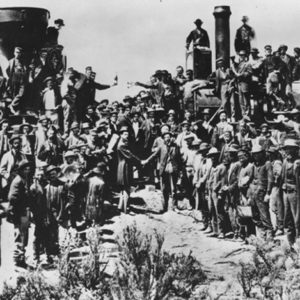One hundred fifty years ago this month, on May 10, 1869, the ceremonial last spike of the first Transcontinental Railroad, referred to as the “Golden Spike,” was driven into the ground, opening the door for rapid expansion of the United States west of the Mississippi River.
The quiz below, from the Ashbrook Center at Ashland University, Ashland, Ohio, provides an opportunity for you to test your knowledge of the Transcontinental Railroad.
1. How many years did it take to complete the Transcontinental Railroad?
A. Four
B. Six
C. Seven
D. Nine
2. The Transcontinental Railroad went between which two cities?
A. San Francisco and New York
B. Oakland and Omaha
C. Sacramento and Philadelphia
D. Los Angeles and St. Louis
3. Who is credited with driving the last spike into the ground and officially opening the railroad?
A. Leland Stanford
B. Theodore Judah
C. Abraham Lincoln
D. George Pullman
4. The Transcontinental Railroad actually was built by three different railroad companies. Which of the following railroads was not one of them?
A. Burlington Northern Santa Fe
B. Central Pacific
C. Union Pacific
D. Western Pacific
5. Where did the lines meet?
A. Colorado
B. Utah
C. Kansas
D. Missouri
6. During the building of the Union Pacific portion of the Transcontinental Railroad, many temporary communities were created along the route. These towns were referred to by what name?
A. Tramp camps
B. Shanty towns
C. Whistle-stop stations
D. Hell on Wheels towns
7. The Transcontinental Railroad dramatically lowered the cost of and time it took to travel to the West, spurring western migration and creating a boon in tourism. Before the railroad, traveling coast to coast cost more than $1,000 (in excess of $18,000 in current dollars) and took six months; after the railroad began service it cost and took:
A. Under $150 and one week
B. Under $250 and 10 days
C. Under $300 and two weeks
D. Under $500 and one month
8. Who was president of the United States when the railroad was completed?
A. Abraham Lincoln
B. Andrew Johnson
C. Ulysses S. Grant
D. Rutherford B. Hayes
9. Several immigrant groups were hired to help build the railroad. Which of the following nationalities was not among them?
A. Chinese
B. Mexican
C. Irish
D. German
10. Members of which Native American tribe acted as scouts for the United States during the building of the railroad?
A. Cherokee
B. Sioux
C. Cheyenne
D. Pawnee
ANSWERS: 1-C, 2-B, 3-A, 4-A, 5-B, 6-D, 7-A, 8-C, 9-B, 10-D

